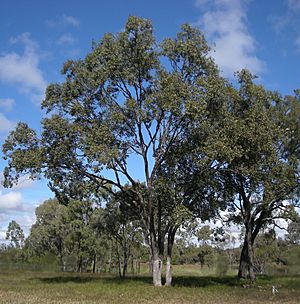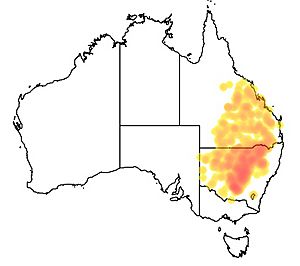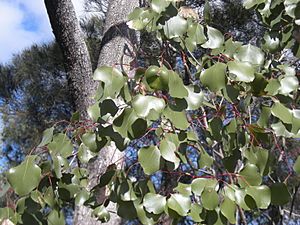Poplar box facts for kids
Quick facts for kids Poplar box |
|
|---|---|
 |
|
| Eucalyptus populnea in central coastal Queensland | |
| Scientific classification | |
| Genus: |
Eucalyptus
|
| Species: |
populnea
|
 |
|
| Distribution of Eucalyptus populnea | |
| Synonyms | |
|
|
The Eucalyptus populnea, often called Poplar Box, Bimble Box, or Bimbil Box, is a tree found only in eastern Australia. It is a small to medium-sized tree. This tree has rough, stringy bark on its trunk and main branches. Its leaves can be egg-shaped, oval, or nearly round. The Poplar Box produces white flowers from groups of seven to fifteen or more flower buds. After flowering, it grows woody, cone-shaped or cup-shaped fruits.
Contents
What Does Poplar Box Look Like?
The Poplar Box tree usually grows up to 20 meters (about 65 feet) tall. It has bark that feels rough, stringy, or flaky. This bark is greyish and covers the trunk and larger branches. Younger branches have smooth, grey bark that peels off in short strips.
Leaves and Flowers
Young Poplar Box plants have dull, greyish-green leaves. These leaves are egg-shaped to almost round. They measure about 60 to 115 millimeters (2.4 to 4.5 inches) long and 35 to 95 millimeters (1.4 to 3.7 inches) wide.
The leaves on older trees are shiny green on both sides. They can be egg-shaped, oval, or almost round. These leaves are 40 to 110 millimeters (1.6 to 4.3 inches) long and 18 to 50 millimeters (0.7 to 2 inches) wide. They have a stalk, called a petiole, that is 10 to 32 millimeters (0.4 to 1.3 inches) long.
The tree's flower buds usually grow in groups of seven to fifteen or more. They are found at the ends of small branches. Each group of buds sits on a stalk 4 to 11 millimeters (0.16 to 0.43 inches) long. The individual buds are oblong to round, about 3 to 5 millimeters (0.12 to 0.2 inches) long. They have a cone-shaped or rounded cap.
Poplar Box trees bloom from August to December. Their flowers are white. After the flowers, the tree produces woody fruits. These fruits are cone-shaped, half-round, or cup-shaped. They are about 2 to 4 millimeters (0.08 to 0.16 inches) long and wide.
Naming the Poplar Box
The Poplar Box was first officially described in 1858. A botanist named Ferdinand von Mueller gave it the scientific name Eucalyptus populnea. The name populnea comes from a Latin word. It refers to how the tree's leaves look similar to those of a poplar tree.
The common names "Bimble Box" and "Bimbil Box" come from the Wiradjuri language. The Wiradjuri people are an Aboriginal group from New South Wales, Australia. Other names for this tree include "round-leaf box" and "shiny-leaf box."
Where Poplar Box Trees Grow
Poplar Box trees are common in New South Wales, Australia. They are found on the western plains, stretching north from towns like Narrandera. Their range extends into Queensland, reaching as far as Rockhampton. These trees are most common in the northern and central parts of the western plains. They become less common in the far west of New South Wales. In those drier areas, they only grow where there is more reliable water and sandy soil.
This type of eucalypt often grows in red soils. These soils can be sandy loam or clay loam. It often grows alongside other trees like Gum Coolibah and Grey Box. It also grows with White Cypress Pine. Less often, it can be found on sandy plains with deep loamy sands. Here, it might grow with Ironwood and Mulga trees. In the far west of New South Wales, it grows in small, sandy areas where water collects.
Poplar Box and Wildlife
The Poplar Box is an important food tree for Koalas. Koalas often eat the leaves of this tree in the areas where it grows.
How People Use Poplar Box
The flowers of the Poplar Box produce good quality honey. This honey is very thick and has a pale amber color. However, there is not a lot of it available.
The wood from the Poplar Box is strong and hard. It is good for making fence posts and for building things. But it can be difficult to work with. It can also be attacked by termites, sometimes called white ants.
This tree is also good for creating a windbreak. It is easy to grow and establish. It makes excellent firewood because it burns cleanly and produces a lot of heat.
Protecting Poplar Box
Even though Poplar Box trees are found in many places, their conservation status is not very good. Along the eastern edge of where they grow, only small groups of these trees remain. This is especially true for trees growing on better soil types. There are also some smaller groups of Poplar Box trees that only grow in limited areas. Very few of these areas are protected in national parks or nature reserves.
One important protected area where many Poplar Box trees can be found is the Yathong Nature Reserve in New South Wales.
See also
 In Spanish: Boj álamo para niños
In Spanish: Boj álamo para niños



